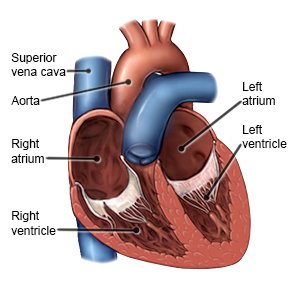Ventricular Heart Pump Insertion or Removal
Medically reviewed by Drugs.com. Last updated on Aug 4, 2025.
What do I need to know about ventricular heart pump (VHP) insertion or removal?
A VHP is a device used for temporary support of your heart's pumping function. It can support your left, right, or both ventricles. The ventricles help pump blood from your heart to the rest of your body. You may need a VHP if your ventricles are weak or damaged. This can happen after a heart attack or if you have heart failure. You may also need a VHP if you are at high risk for problems during a coronary artery procedure.
 |
How do I prepare for the procedure?
- Your healthcare provider will tell you how to prepare. Your provider may tell you not to eat or drink anything after midnight on the day of your procedure. Arrange to have someone drive you home when you are discharged.
- Tell your provider about all medicines you currently take. Your provider will tell you if you need to stop any medicine for the procedure, and when to stop. Your provider will tell you which medicines to take or not take on the day of the procedure.
- Tell your provider about any allergies you have, including to anesthesia or medicines.
- You may need blood tests or an echocardiogram before the procedure. Your provider will tell you when to have these tests done.
Related medications
What will happen during the procedure?
- You may be given general anesthesia to keep you asleep and free from pain during surgery. You may instead be given local anesthesia to numb the procedure area. With local anesthesia, you may still feel pressure or pushing during surgery, but you should not feel any pain.
- Your provider will make a small incision near your groin or collar bone. Your provider will insert a catheter into a nearby artery. The catheter will be guided to your heart. Your provider may use continuous x-ray pictures or echocardiography to make sure the catheter is in the correct place. When the catheter is in the correct position, your provider will place the heart pump. Your provider may flush the catheter with a blood thinner such as heparin. This will help prevent clots from forming in and around the catheter.
- The heart pump will be turned on. The catheter will stay in place until the heart pump is removed. To remove the heart pump, your provider will turn the pump off. The heart pump and catheter will then be removed. Your provider will apply pressure to the catheter site. A bandage may be placed over the area.
What should I expect after the procedure?
You will need to stay in the hospital while the VHP is in place. You may receive medicines to treat pain or prevent a blood clot during this time.
- Healthcare providers will monitor your vital signs and catheter site. You may have to lie in certain positions to keep the catheter from bending. Healthcare providers will help you move around. Do not get out of bed on your own. Call healthcare providers if you need to move or get out of bed.
- The heart pump will be connected to a monitor. This monitor will show healthcare providers how well the pump is working. Healthcare providers will be able to change the settings on the heart pump, if needed.
- Healthcare providers will begin weaning you off of the pump after several hours or days. This will depend on your condition. Providers will slowly start lowering the settings of the pump to see how well your heart is working on its own. You may need a different device if your heart needs long-term support.
What are the risks of VHP insertion or removal?
You may bleed more than expected or develop an infection. The valves in your heart may be damaged. You may develop an abnormal heart rhythm. Your red blood cells may be damaged or destroyed. Your limbs may not get enough blood. This can lead to tissue death, and amputation may be needed. Your device may move out of place or stop working. You may need more surgery to fix this. You may develop a blood clot or have a stroke. This can be life-threatening.
Care Agreement
You have the right to help plan your care. Learn about your health condition and how it may be treated. Discuss treatment options with your healthcare providers to decide what care you want to receive. You always have the right to refuse treatment. The above information is an educational aid only. It is not intended as medical advice for individual conditions or treatments. Talk to your doctor, nurse or pharmacist before following any medical regimen to see if it is safe and effective for you.© Copyright Merative 2025 Information is for End User's use only and may not be sold, redistributed or otherwise used for commercial purposes.
Further information
Always consult your healthcare provider to ensure the information displayed on this page applies to your personal circumstances.
